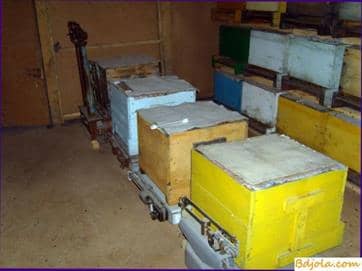
You can carry bees for winter. These winterers are either especially suited, or accommodate empty buildings. Some large beekeeping farms use subterranean and semi-underground zymovniki. Beekeepers-lovers, especially in places with severe winter, often put beehives in and underground homes.
Zimovniki protect bees from winds and frosts, and even those equipped can even maintain the necessary temperature and humidity. It is believed that bees behave calmly at room temperature from 0 to + 4 њ C and humidity not higher than 80%. It is extremely important to have good ventilation with the help of a supply and exhaust system of the air exchanger and adjust the temperature and humidity.
The bees are removed, as it becomes clear that the cold weather has come. You should not hurry. Early frosts and snow are not yet winter and in no case a signal for carrying beehives into winter huts. Be afraid that the walls of the hives will cool down, and in the shelter will be sweated and become damp, there are no grounds. If the room is well ventilated, dampness in the hives is not created.
Following the cold days, warm and favorable weather often arrives for a late flight. Bees locked in a stuffy winterhouse or cellar, feeling this heat, worry, make noise, fly out of the hives. Often the intensive ventilation of the room does not help.
There is a golden rule, worked out by many years of practice, later put the bees in the winter hut, before exhibiting in the spring. Then how to transfer the hives, lock the tapes so that the bees can not get out. Carry on a stretcher, carefully, trying to get rid of bumps and jolts. They put in rows in a winter hut, sometimes 2 floors, with tapholes inside the room.
As soon as all the hives have been placed, they open the lower upper flanges, barred by the barriers. The danger of the penetration of mice in the hives in the room is many times higher than in winter at will. On the floor, in the corners, put mousetraps or lay out poisoned baits.
To monitor the temperature and humidity of the air, the room is hung with a thermometer and a psychrometer.
They enter the winter quarters not more than once a month, as well as in a thaw and severe frosts. A frequent visit is disturbing and they are worried, and then they do not calm down for a long time. When viewed, use a flashlight with a red glass. White light excites bees. Watch the ventilation of the hives and the room.
Especially the great need for fresh air arises in bees with the appearance of brood. After all, the growing body needs oxygen. To make a nutritive mass, the larvae need water. Its bees are obtained from outside air, the moisture of which is just, and contributes to this. Therefore, by spring, ventilation is enhanced. Ventilation not only reduces the temperature of the spirit in the hibernate and hives, but also increases its humidity, if dry, or, conversely, reduces it if it is too high, that is, creates an environment conducive to the wintering of bees.
The art of the beekeeper is manifested in the wintering. It is rightly called the foundation of beekeeping.
With the first spring warming, the hives are carried to the apiary. Let the snow still lay, but gray alder and hazelnut are already spreading their earrings, and here and there the mother-and-stepmother has gilded on the thawed patches and slopes. And as soon as the sun warms up, everything will revive around with bee-ringing. And in the hives, a new generation has already appeared and every day the uterus puts more and more eggs. The beekeeping season began.
Консервирование шкурок. Влияние меда на печень мед.
Hives, inventory